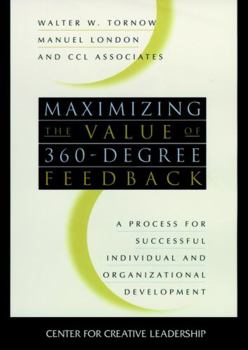Maximizing the Value of 360-Degree Feedback: A Process for Successful Individual and Organizational Development
Select Format
Select Condition 
Book Overview
The comprehensive guide to 360-degree feedback from the Center for Creative Leadership
In the network economy, growing intellectual capital is the key to increasing market value. In Maximizing, Tornow, London, and their associates demonstrate the power of 360-degree feedback for developing managers, renewing organizations, and building learning cultures. Drawing on years of experience and state-of-the-art research, the authors have crafted...
Format:Hardcover
Language:English
ISBN:0787909580
ISBN13:9780787909581
Release Date:March 1998
Publisher:Jossey-Bass
Length:320 Pages
Weight:1.22 lbs.
Dimensions:1.1" x 6.2" x 9.5"
Related Subjects
Business Business & Finance Business & Investing Business Development Economics Entrepreneurship Human Resources Human Resources & Personnel Management Industries & Professions Management Management & Leadership Occupational & Organizational Psychology Small Business & Entrepreneurship Social SciencesCustomer Reviews
2 ratings
A good practical overview of a performace management best practice
Published by Thriftbooks.com User , 18 years ago
A 360-degree feedback survey collects inputs from bosses, subordinates, peers, clients and customers and even self-evaluations to create a complete picture of performance, pinpointing areas for improvement. This is a more reliable indicator of performance because no one person is able to see all aspects of an employee's performance, or to report on all of the many roles that an employee may fill. The authors believe that you should use the information from 360-degree performance evaluation not just on an individual basis, but as a foundation for an organization-wide performance management system that applies to every individual and group in the company. A performance management system can help your organization in many ways: 1. By creating a focus for employees on the skills and competencies that are crucial to the organization, aligning individual goals with company goals. 2. By reinforcing the working relationships throughout your company that contribute to performance and success. 3. By creating a corporate learning culture. There's a lot out there now on 360 Degree Feedback. This book is concise and practical. A good resource.
Why Do We Measure?
Published by Thriftbooks.com User , 24 years ago
"For several reasons", M.London and W.Tornow write, "360-degree feedback has become a popular technique in organizations today. The complexity of jobs requires that employees have feedback from a variety of constituencies, not just their supervisor, who has traditionally been the source of feedback and performance review. Also, organizational restructuring and downsizing place the burden of development on the employee. Today's organizations generally do not provide structured career paths with promises of job security and advancement. Rather, individuals need to be responsible for their continued ability to add value to the organization. The organization enables this by providing a variety of resources, which often include access to training to improve current job performance and prepare for tomorrow; 360-degree feedback may be part of this development process (from the Introduction pp. 2-3)."In this context, as a collection of chapters addressing the broad issue of using 360-degree feedback for individual and organizational development, authors from Center for Creative Leadership (CCL) :* review origins of 360-degree feedback in organizations.* discuss the standards and dimensions of performance that are rated in a 360-degree survey.* focus on the quality of the ratings and the information they convey to the feedback recipients.* examine the outcomes of the 360-degree feedback for performance improvement and development.* describe the kind of program (Leadership Development Program) that can enhance the 360-degree feedback process by presenting a case study.* consider the benefits of the 360-degree feedback process for organizations and how current practices affect these benefits.* describe the internal and external forces affect the process of 360-degree feedback.* examine the advantage of involving customers in the 360-degree feedback process and in the development of organizational strategy.* show how 360-degree feedback can be an integral part of establishing a learning culture.* focus on standard 360-degree feedback instruments such as : (1) the questionnaire, (2) the scored feedback (or results), and (3) the administrative process.* discuss what is involved in applying the 360-degree feedback process in different countries in a multinational organization.* focus on using 360-degree feedback surveys to measure what happens as a result of an intervention rather than using the data from 360-degree feedback to identify a needed development intervention."In conclusion", W.Tornow and M.London write, "organizations can maximize the value of 360-degree feedback as a process that will create successful individual and organizational development. This can be done by being intentional and systemic when designing and implementing a 360-degree feedback program such that it fits with the intended purpose, is aligned with the business goals and strategies, and is integrated with other HR systems (from the Conclusion






